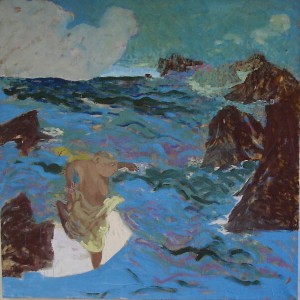A seascape which prolongs the sea sprays of Monet: Mary Sallantin’s Aphrodite first bathes in painting, at her feet a patch of unpainted canvas underlining this contention. This Aphrodite, this Venus, this beauty is attired in truth, a nude emerging from the waves, embodies painting of the XXI century. Absolutely free to be who she is, taking on these shapes and colors in a defined choreographed form, a carnal swell engaged in a waltz with the sky, the sun and the sea, she offers herself to beholding eyes like a woman to the bounties of the beach.
Aphrodite of the XXI century is a fine lass and happy at that. Not proud with that. At ease, nat-ur-al, a bit sassy for sure, but not loose living, this Venus is not venal, beautiful she is, but not like in a painting by Cabanel nor is she Bouguereaulike or Botticellish on her conch as if on a pedestal. On she goes, basking in the sun, devoid of tension: there are goddesses indeed so godly that they discourage women from being women, but not her. Mary Sallantin’s Olympus drops in from next door.
This is how Mary Sallantin’s Aphrodite represents the Otium, not in vain idleness but in happiness of being. Prevert, not too long ago made her acquaintance:
I am what I am
It is just what I am
When I feel like laughing
Well I laugh right out loud
…
What more do you want?
What do you want of me?*
Christine Sourgins, art historian
*Excerpt from Jacques Prévert, “Paroles.
